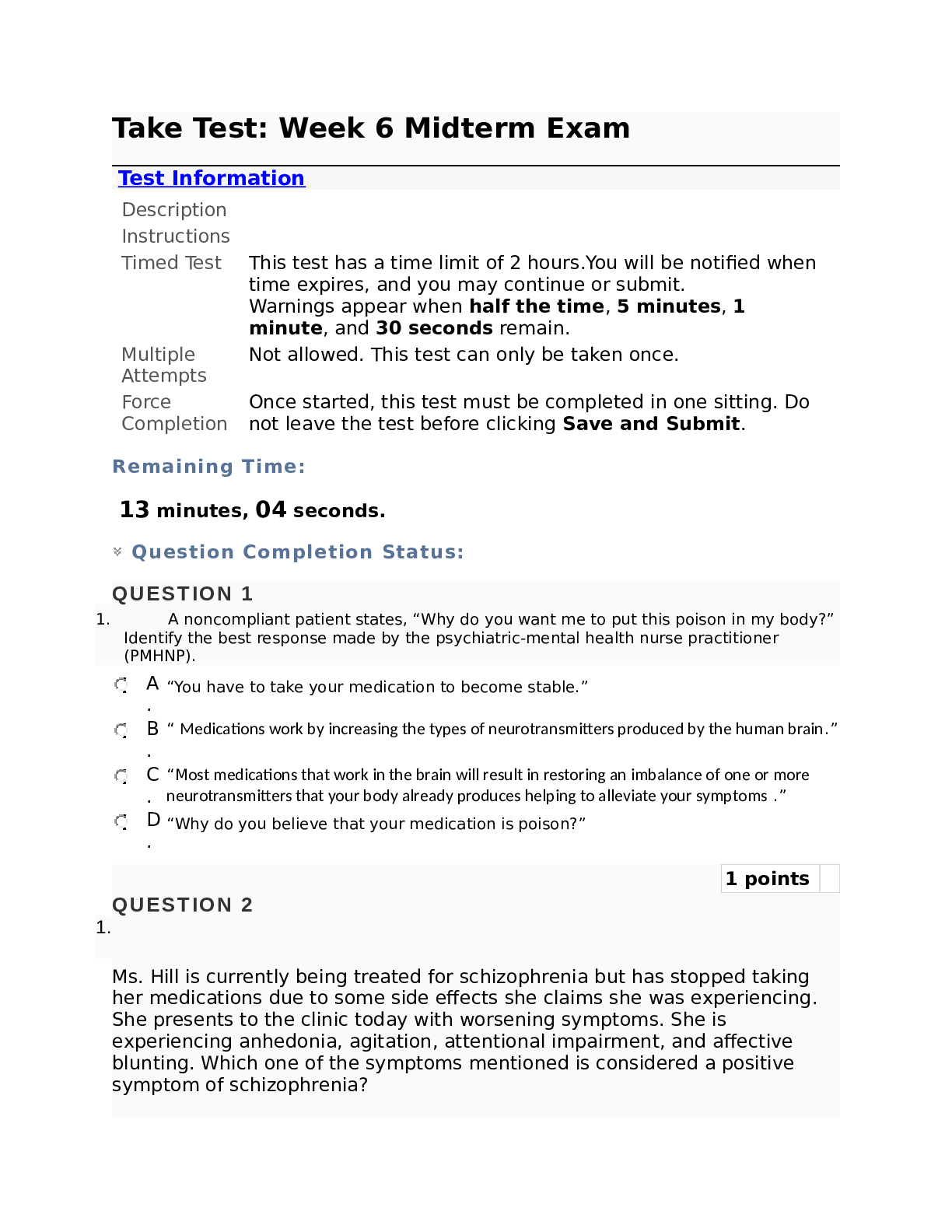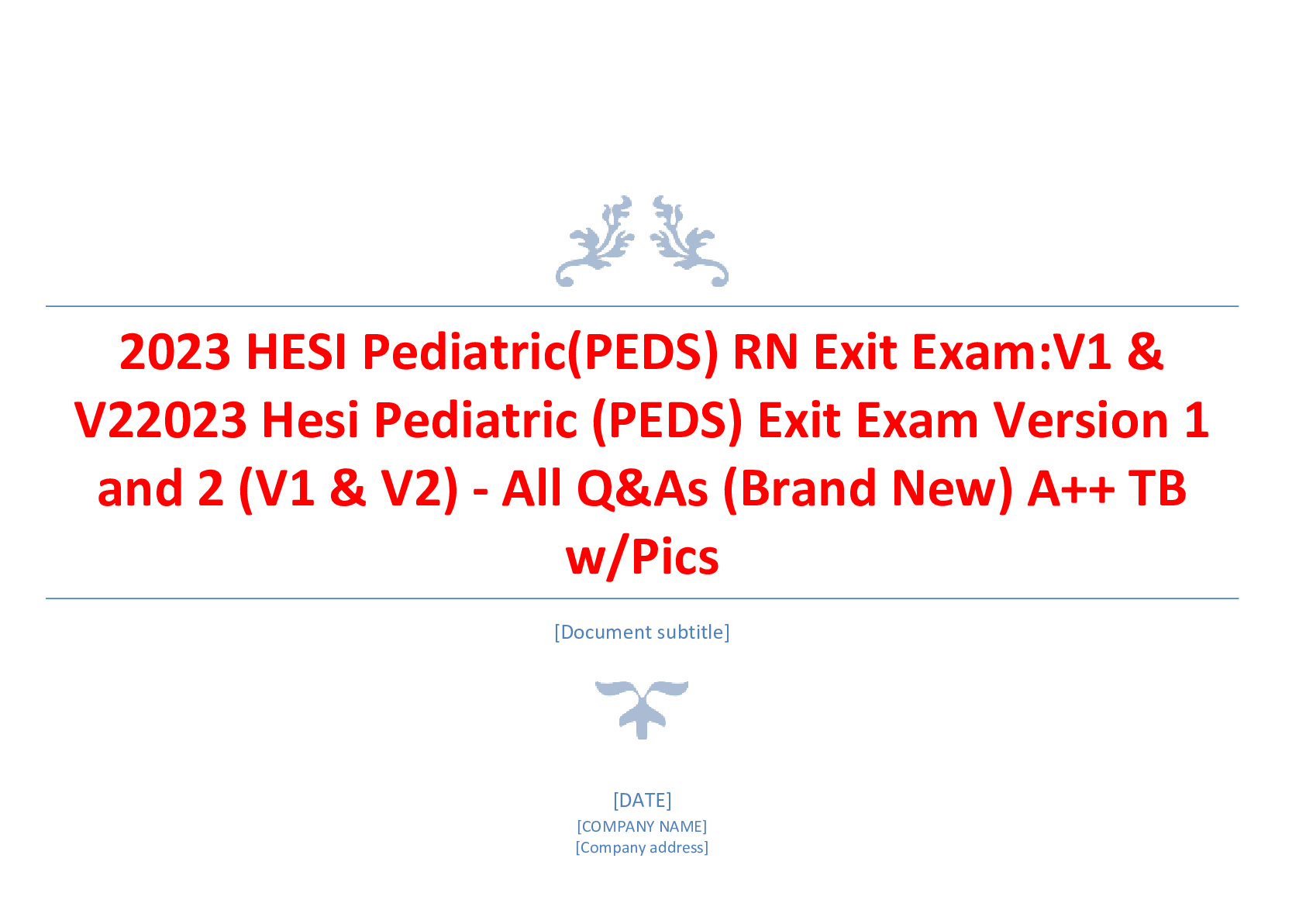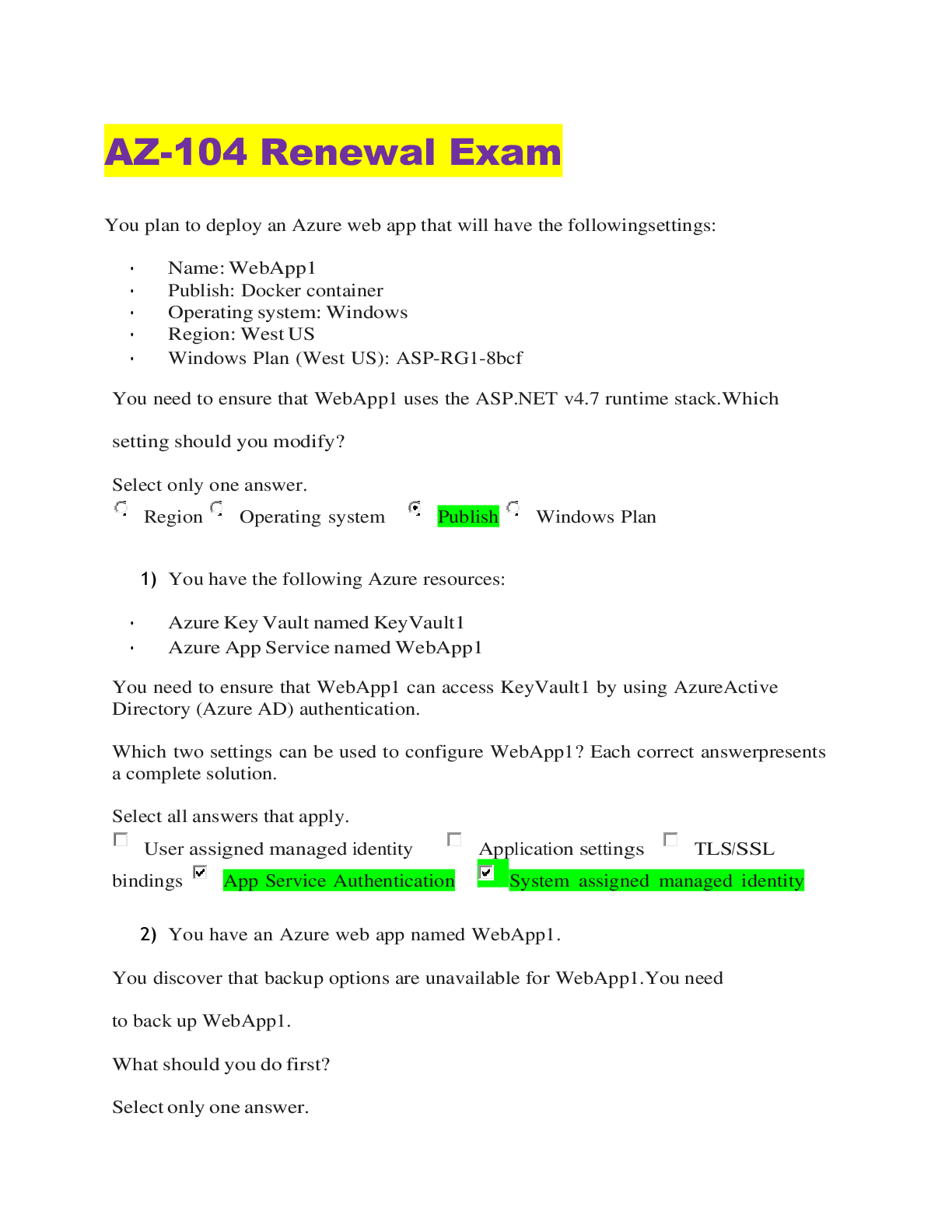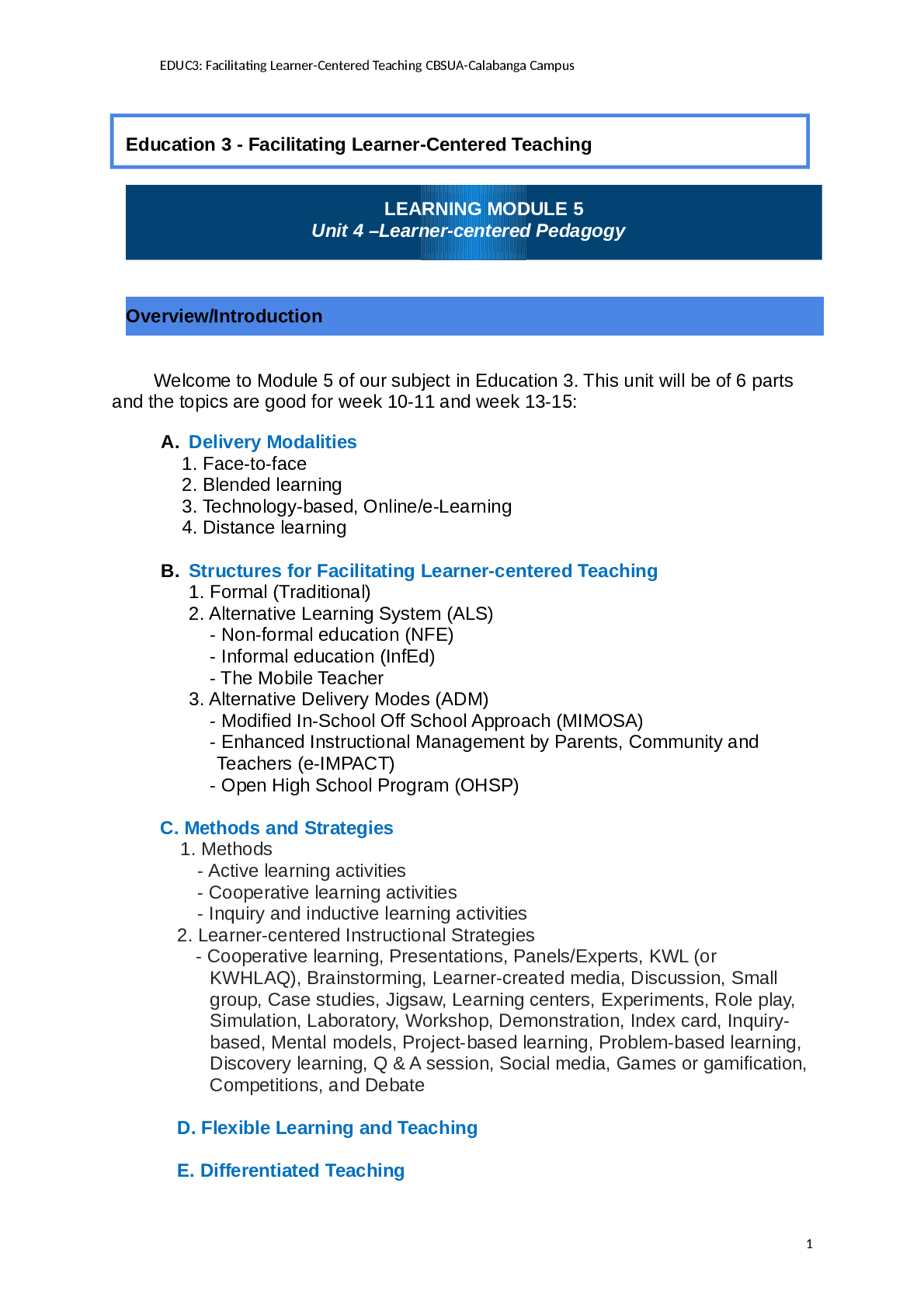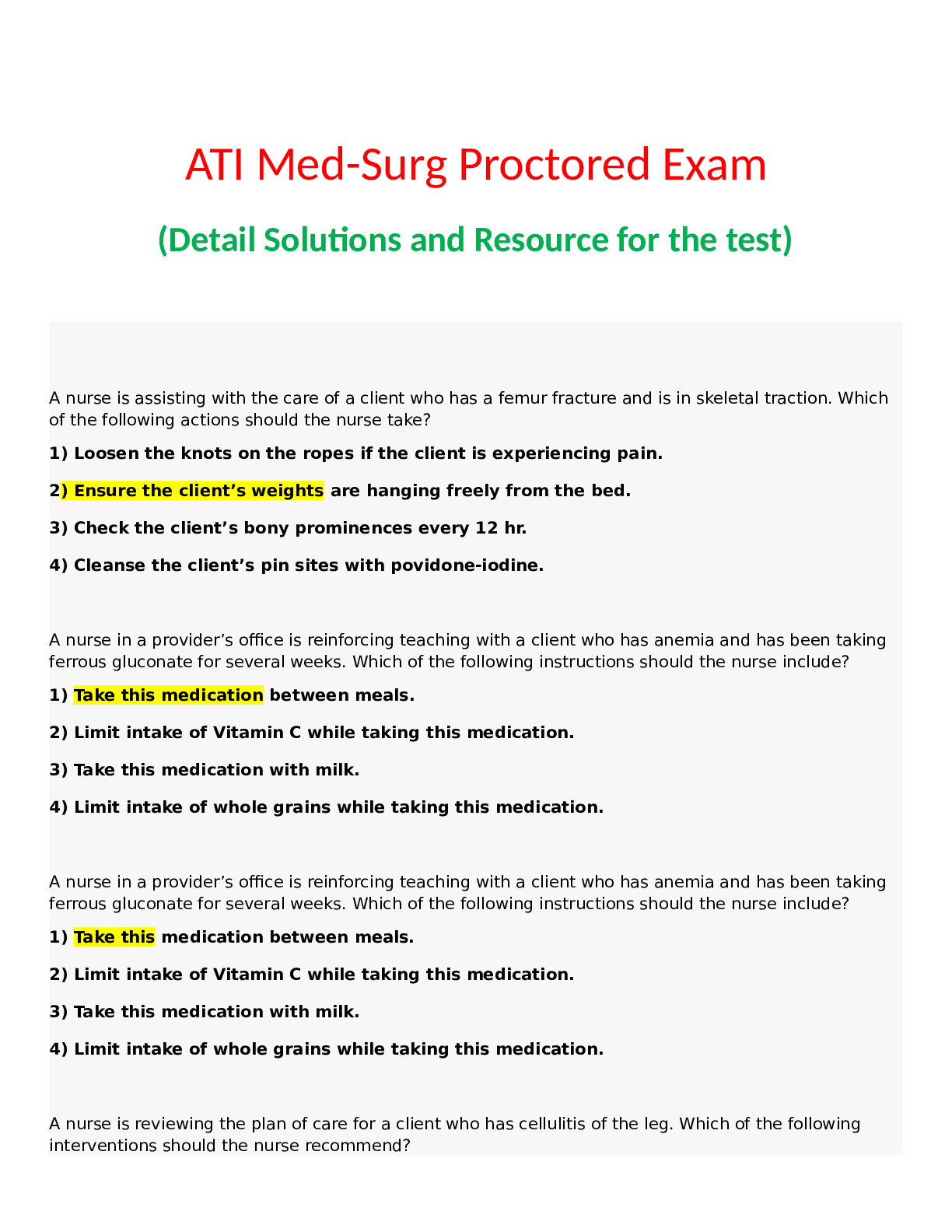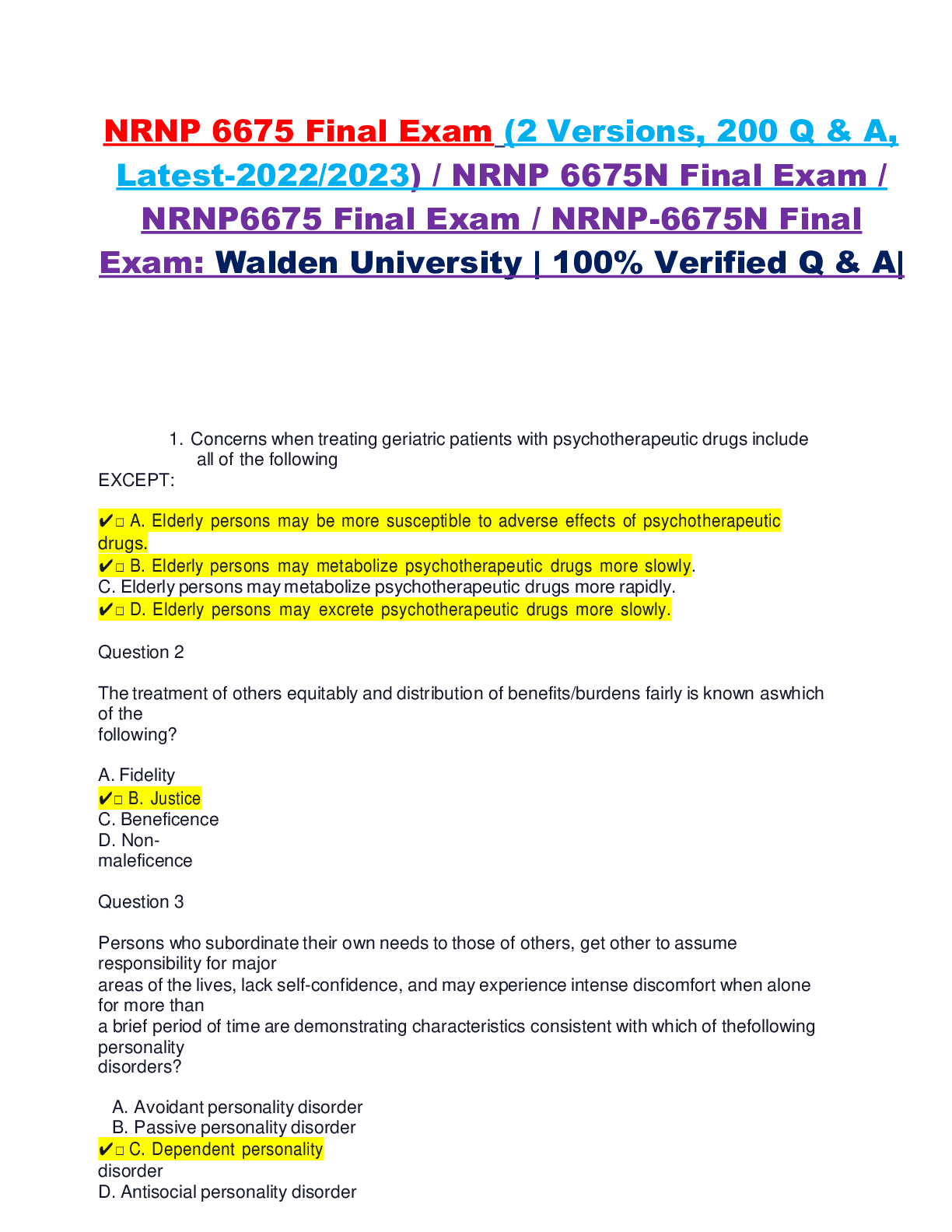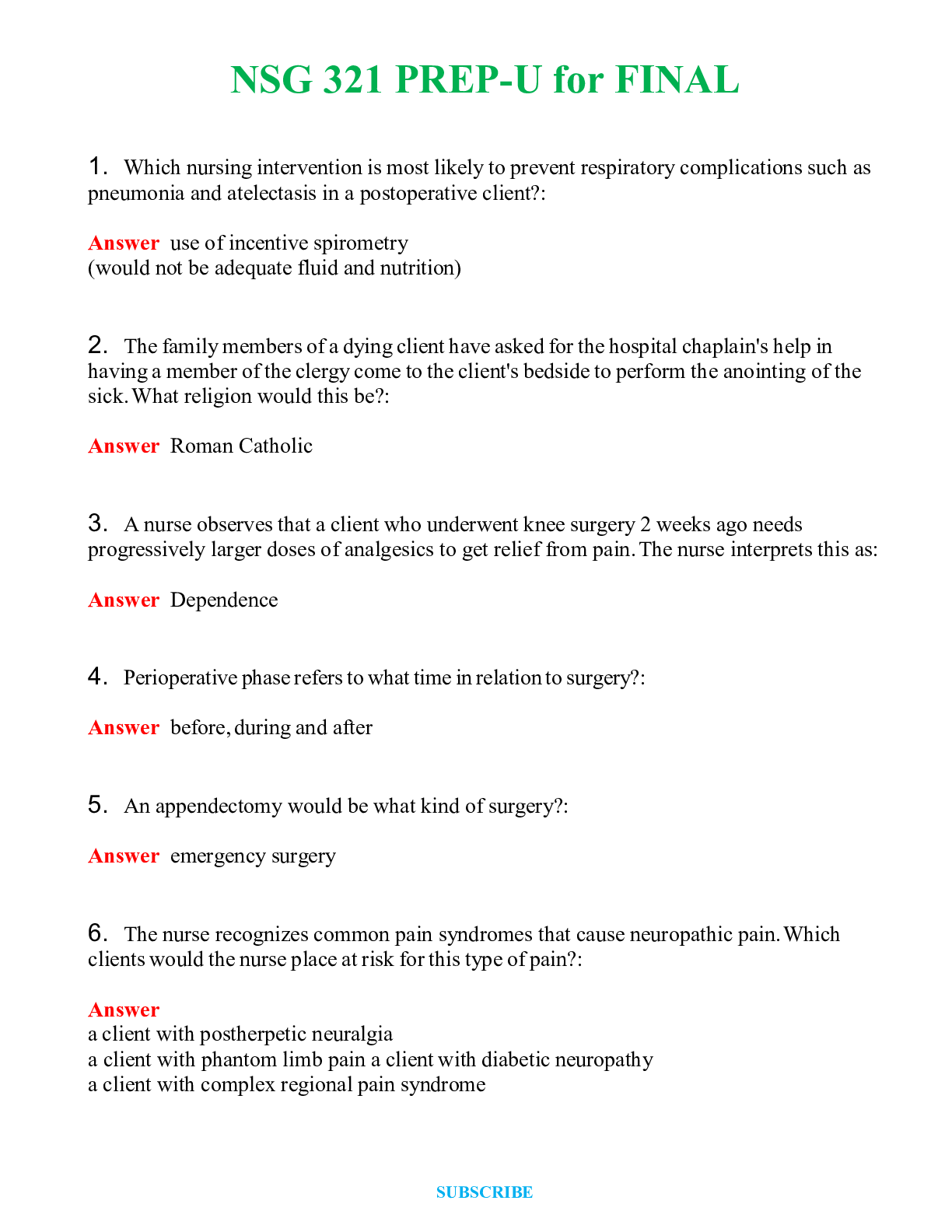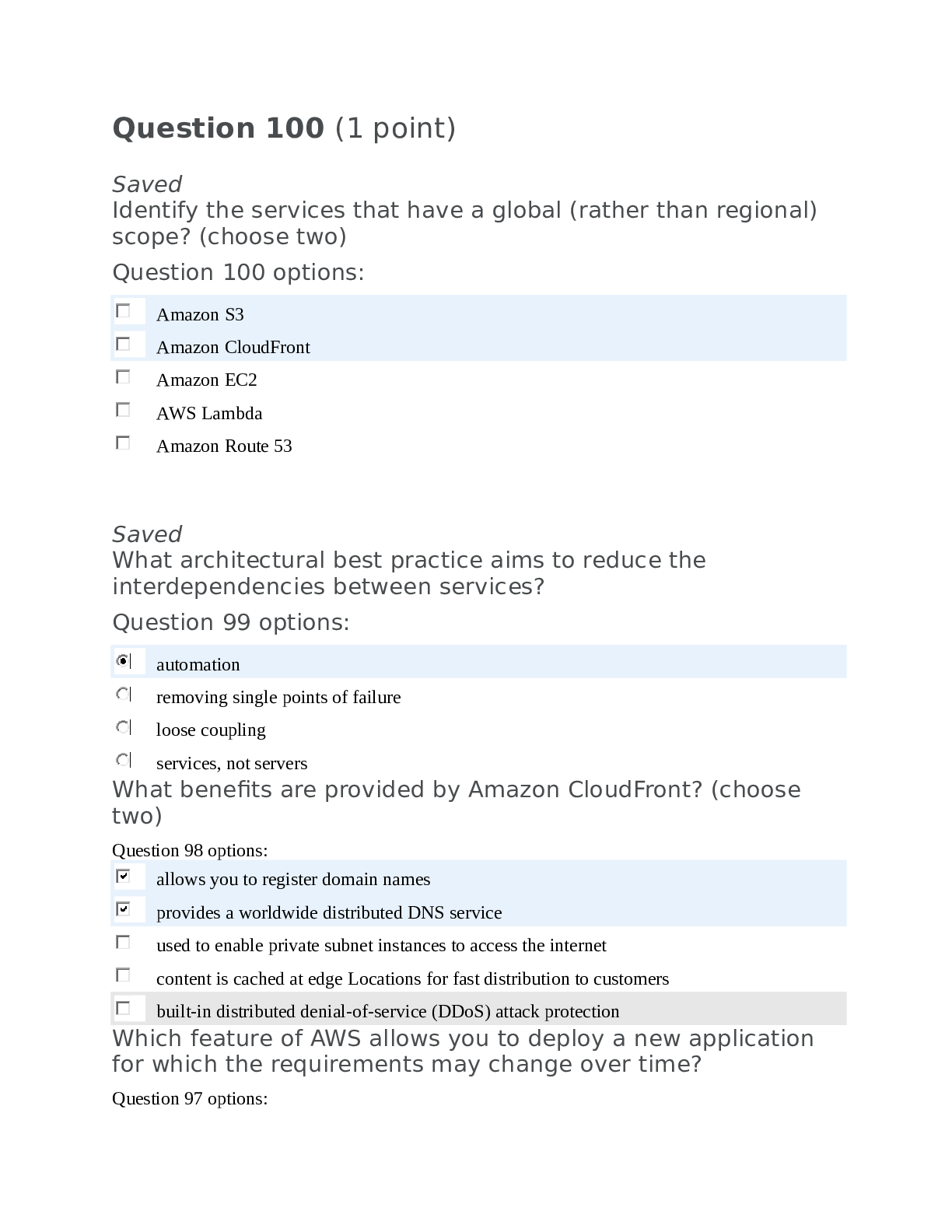*NURSING > EXAM > NURS-6630N-4/NURS-6630F-4/NURS-6630C-4-Approaches to Treatment2020 Summer Qtr 06/01-08/23-PT27 (All)
NURS-6630N-4/NURS-6630F-4/NURS-6630C-4-Approaches to Treatment2020 Summer Qtr 06/01-08/23-PT27
Document Content and Description Below
Antihistamines may cause side eOects such as blurred vision, constipation, memory problems, and dry mouth. This is due to the eGects of antihistamines. Selected Answer: a. Anticholinergic ... Question 2 1 out of 1 points A 26-year-old female patient with nicotine dependence and a history of anxiety presents with symptoms of attention de cit hyperactivity disorder (ADHD). Based on the assessment, what does the PMHNP consider? Selected d. Answer: ADHD is often not the focus of treatment in adults with comorbid conditions. Question 3 0 out of 1 points Molly is a 52-year-old female that has a diagnosis of bromyalgia. She complains of fatigue and cognitive di culties. Which medication is the PMHNP most likely to prescribe? Selected Answer: c. Topiramate (TOPAMAX) Question 4 1 out of 1 points A patient with gambling disorder and no other psychiatric comorbidities is being treated with pharmacological agents. Which drug is the PMHNP most likely to prescribe? Selected Answer: d. Naltrexone Question 5 1 out of 1 points Which of the following is considered as a disruptive/impulse control behavior? Selected Answer: a. Pyromania Question 6 1 out of 1 points Kevin is an adolescent who has been diagnosed with kleptomania. His parents are interested in seeking pharmacological treatment. What does the PMHNP tell the parents regarding his treatment options? Selected Answer: c. “Naltrexone may be an appropriate option to discuss.” Question 7 1 out of 1 points A young patient is prescribed Vyvanse. During the follow-up appointment, which comment made by the patient makes the PMHNP think that the dosing is being done incorrectly? Selected Answer: b. “I am unable to fall asleep at night.” Question 8 1 out of 1 points The novel neurotransmitter adenosine is responsible for the sleep-wake cycle by increasing throughout the day and diminishing during night. Which of the follow is an antagonist of adenosine? Selected Answer: a. Ca eine Question 9 1 out of 1 points What will the PMHNP most likely prescribe to a patient with psychotic aggression who needs to manage the top-down cortical control and the excessive drive from striatal hyperactivity? Selected Answer: a. Antipsychotics Question 10 1 out of 1 points Mike wants to quit smoking. He has tried nicotine replacement and varenicline without success. He has asked for another medication to help him kick his habit. The PMHNP decides to try a medication that increases dopamine by prescribing a medications that can increase both norepinephrine and dopamine. Which medication did the PMHNP prescribe? Selected Answer: c. Bupropion (ZYBAN) Question 11 1 out of 1 points The PMHNP has been asked to provide an in-service training to include attention to the use of antipsychotics to treat Alzheimer’s. What does the PMHNP convey to sta ? Selected c. Answer: The use of an psycho cs may cause increased cardiovascular events and mortality and an psycho cs are o en used as “chemical straightjackets” to over- tranquilize pa ents. Question 12 1 out of 1 points The PMHNP is caring for a patient who openly admitted to drinking a quart of vodka daily. Prior to prescribing this patient disulJram (Antabuse), it is important for the PMHNP to: Selected Answer: b. Evaluate the patient’s willingness to abstain from alcohol 3/15 Question 13 1 out of 1 points The PMHNP prescribes gabapentin (Neurontin) for a patient’s chronic pain. How does the PMHNP anticipate the drug to work? Selected d. Answer: It will bind to the alpha-2-delta ligand subunit of voltage-sensitive calcium channels. Question 14 1 out of 1 points The parents of a 7-year-old patient with ADHD are concerned about the eects of stimulants on their child. The parents prefer to start pharmacological treatment with a non-stimulant. Which medication will the PMHNP will most likely prescribe? Selected Answer: d. Strattera Question 15 1 out of 1 points A patient diagnosed with obsessive compulsive disorder has been taking a high-dose SSRI and is participating in therapy twice a week. He reports an inability to carry out responsibilities due to consistent interferences of his obsessions and compulsions. The PMHNP knows that the next step would be which of the following? Selected Answer: a. Decrease his SSRI and add buspirone (Buspar). Question 16 1 out of 1 points The PMHNP wants to use a symptom-based approach to treating a patient with Fbromyalgia. How does the PMHNP go about treating this patient? Selected b. Answer: Matching the patient’s symptoms with the malfunctioning brain circuits and neurotransmitters that might mediate those symptoms. Question 17 1 out of 1 points The PMHNP prescribes pregabalin (LYRICA) for a patient with chronic pain. How does pregabalin work to reduce pain? Selected a. Answer: It will block excitatory neurotransmission by blocking voltage-sensitive calcium channels. Question 18 1 out of 1 points Karen completes the Epworth sleepiness scale and scores abnormally high. She is diagnosed with narcolepsy. The PMHNP prescribes a wake-promoting agent that is a weak dopamine transporter antagonist. Which medication did the PMHNP prescribe? Selected Answer: a. Modafanil (PROVIGIL) Question 19 1 out of 1 points The PMHNP understands that slow-dose extended release stimulants are most appropriate for which patient with ADHD? Selected Answer: c. 8-year-old patient Question 20 1 out of 1 points Sharon is a 56-year-old female that presents to the clinic with pain after suGering a back injury several years ago. The patient states she feels a tingling sensation in her legs. What type of pain is Sharon likely experiencing? Selected Answer: c. Neuropathic pain Question 21 1 out of 1 points Antipsychotics are doses at a level that blocks % of D2 receptors. Selected Answer: d. 60-80 Question 22 0 out of 1 points Neal is complaining of restless leg syndrome and insomnia. Which Nrst-line medication should the PMHNP prescribe to treat both? Selected Answer: d. Gabapentin (NEURONTIN) Question 23 1 out of 1 points An 8-year-old patient presents with severe hyperactivity, described as “ants in his pants.” Based on self-report from the patient, his parents, and his teacher; attention deRcit hyperactivity disorder (ADHD) is suspected. What medication is the PMNHP most likely to prescribe? Selected Answer: a. Methylphenidate (Ritalin, Concerta) Question 24 0 out of 1 points Which of the following anticonvulsants increases serotonergic neurotransmission and GABAergic transmission, while decreasing glutamatergic neurotransmission? Selected Answer: c. Lamotrigine (LAMICTAL) Question 25 1 out of 1 points The nursing staU asks the PMHNP for additional education regarding the treatment of agitation in dementia patients. Which of the following is correct? Selected c. Answer: The nurse should attempt to determine how the patient's environment may be impacting the patient's mood. Question 26 1 out of 1 points The PMHNP is assessing a patient she has been treating with the diagnosis of chronic pain. During the assessment, the patient states that he has recently been having trouble getting to sleep and staying asleep. Based on this information, what action is the PMHNP most likely to take? Selected Answer: a. Order hydroxyzine (Vistaril), 50 mg PRN or as needed Question 27 1 out of 1 points The PMHNP wants to prescribe Mr. Barber a mood stabilizer that will target aggressive and impulsive symptoms by decreasing dopaminergic neurotransmission. Which mood stabilizer will the PMHNP select? Selected Answer: a. Lithium (Lithane) Question 28 1 out of 1 points A 75-year-old male patient diagnosed with Alzheimer’s disease presents with agitation and aggressive behavior. The PMHNP determines which of the following to be the best treatment option? Selected Answer: c. Citalopram (Celexa) or Escitalopram (Lexapro) Question 29 0 out of 1 points Harold complains of pain associated with his irritable bowel syndrome with constipation. The PMHNP decides to prescribe a medication that prevents pain signals from reaching the brain. Which agent does the PMHNP prescribe? Selected Answer: b. Venlafaxine (EFFEXOR) Question 30 0 out of 1 points The PMHNP is meeting with the parents of an 8-year-old patient who is receiving an initial prescription for D-amphetamine. The PMHNP demonstrates appropriate prescribing practices when she prescribes the following dose: Selected Answer: d. The child’s dose will increase by 2.5 mg every other week. [Show More]
Last updated: 1 year ago
Preview 1 out of 17 pages

Reviews( 0 )
Document information
Connected school, study & course
About the document
Uploaded On
Aug 11, 2022
Number of pages
17
Written in
Additional information
This document has been written for:
Uploaded
Aug 11, 2022
Downloads
0
Views
29



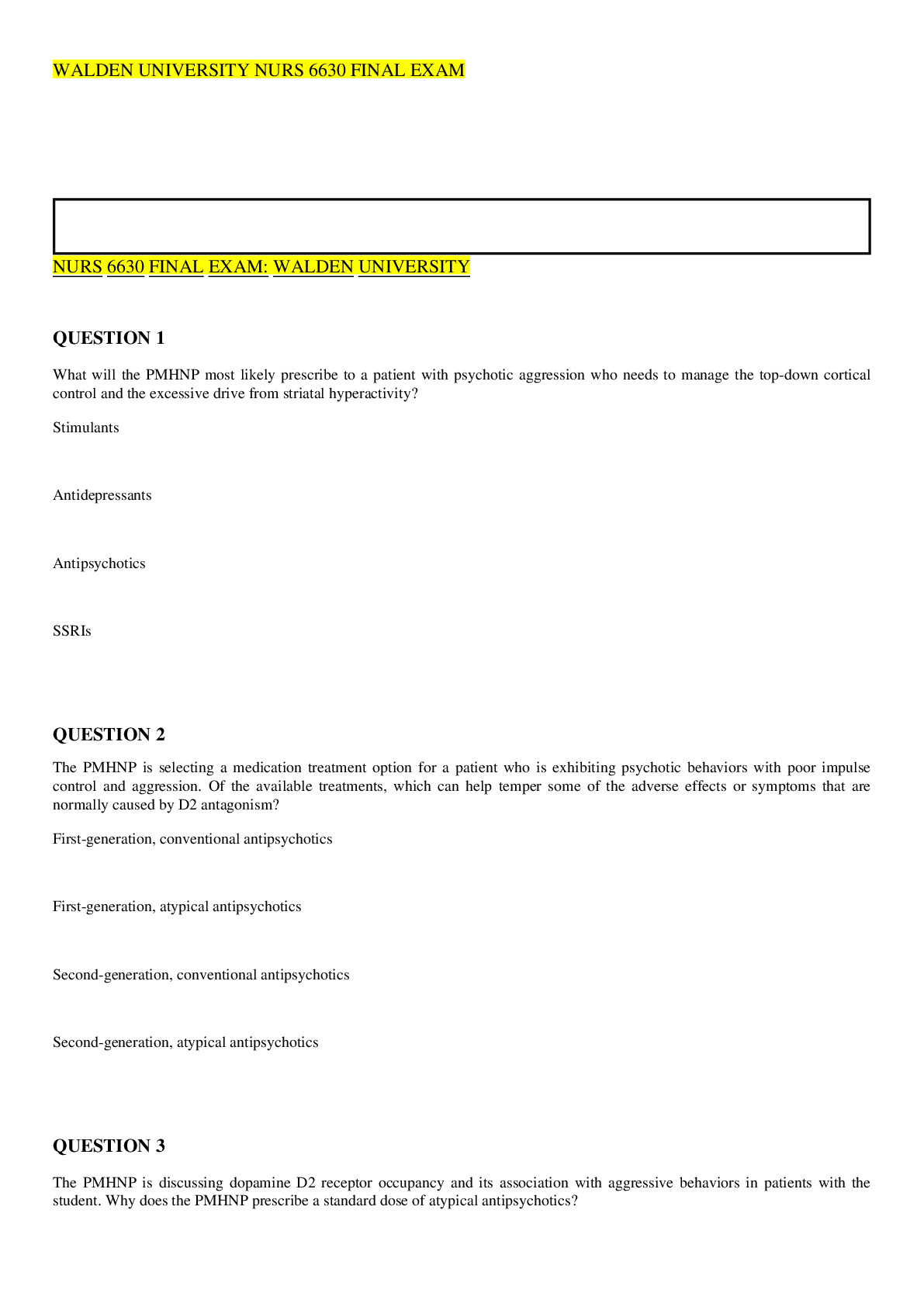
 (1).png)


